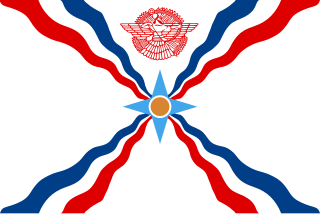Margavar Rural District is a rural district (dehestan) in Silvaneh District, Urmia County, West Azerbaijan Province, Iran. At the 2006 census, its population was 34,862, in 6,012 families. The rural district has 53 villages.

Khanileh is a village in Dowlatabad Rural District, in the Central District of Ravansar County, Kermanshah Province, Iran. At the 2006 census, its existence was noted, but its population was not reported.

Sharafabad is a village in Kuhsar Rural District, in the Central District of Shazand County, Markazi Province, Iran, close to Lake Urumia. The village was founded by Sharaf-ud-din in 1210 AD and was named after himself. At the 2006 census, its existence was noted, but its population was not reported. The trade is mainly in grain, cotton, molasses as well as some deposits of gold. Archaeologists discovered many clay pots from the Uruk period in Sharafabad, the pots were burned as offerings to deities. During a two year drought the inhabitants switched to handicraft production to supplement income in order to survive.

Temenuiyeh is a village in Rezvan Rural District, Jebalbarez District, Jiroft County, Kerman Province, Iran. At the 2006 census, its existence was noted, but its population was not reported.

Jiruiyeh is a village in Dalfard Rural District, Sarduiyeh District, Jiroft County, Kerman Province, Iran. At the 2006 census, its existence was noted, but its population was not reported.

Leguri is a village in Gevar Rural District, Sarduiyeh District, Jiroft County, Kerman Province, Iran. At the 2006 census, its existence was noted, but its population was not reported.

Bizhanabad is a village in Khatunabad Rural District, in the Central District of Jiroft County, Kerman Province, Iran. At the 2006 census, its existence was noted, but its population was not reported.

Madan Raz is a village in Sharifabad Rural District, in the Central District of Sirjan County, Kerman Province, Iran. At the 2006 census, its population was 219, in 50 families.

Darbid is a village in Sar Firuzabad Rural District, Firuzabad District, Kermanshah County, Kermanshah Province, Iran. At the 2006 census, its existence was noted, but its population was not reported.

Murchi is a village in Baladarband Rural District, in the Central District of Kermanshah County, Kermanshah Province, Iran. At the 2006 census, its existence was noted, but its population was not reported.

Khosrowabad is an Assyrian village in Zulachay Rural District, in the Central District of Salmas County, West Azerbaijan Province, Iran. At the 2006 census, its population was 158, in 44 families.

Jamalabad is an Assyrian village in Anzal-e Shomali Rural District, Anzal District, Urmia County, West Azerbaijan Province, Iran. At the 2006 census, its population was 209, in 67 families.

Gol Pashin is a village in Bakeshluchay Rural District, in the Central District of Urmia County, West Azerbaijan Province, Iran. At the 2006 census, its population was 266, in 69 families. Gol Pashin is an Assyrian village and has 1 surviving church, although before it was destroyed in 1918 it had many more, and was a much grander and significant town overall.

Adeh is a village in Tala Tappeh Rural District, Nazlu District, Urmia County, West Azerbaijan Province, Iran. At the 2006 census, its population was 151, in 41 families.

Chamaki is a village in Tala Tappeh Rural District, Nazlu District, Urmia County, West Azerbaijan Province, Iran. At the 2006 census, its existence was noted, but its population was not reported. Around 600 Assyrian populated the village, the language spoken was Modern Assyrian. The local church is known as Saint Merry.

Mushabad is an Assyrian village in Tala Tappeh Rural District, Nazlu District, Urmia County, West Azerbaijan Province, Iran. At the 2006 census, its existence was noted, but its population was not reported.

Sopurghan is a village in Tala Tappeh Rural District, Nazlu District, Urmia County, West Azerbaijan Province, Iran. At the 2006 census, its population was 243, in 71 families.

Mobarakeh is a village in Ramsheh Rural District, Jarqavieh Olya District, Isfahan County, Isfahan Province, Iran. At the 2006 census, its population was 301, in 85 families. In its latest census of 2018, its population was 260, in 68 families.







